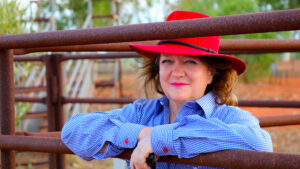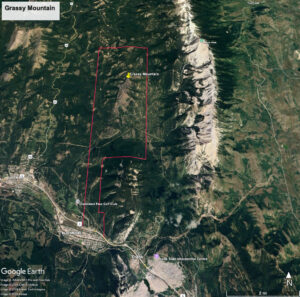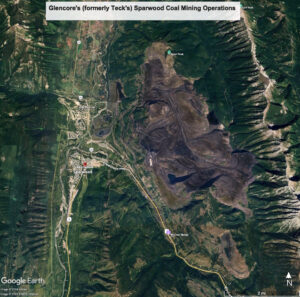Updated 28 October 2024
This post is contributed by Ian Urquhart who taught political science at the University of Alberta for over thirty years. He is the author of Costly Fix: Power, Politics and the Nature of the Tar Sands.

You may have to fight a battle more than once to win it.
– Margaret Thatcher
Zombies. The Undead. They’re in neighbourhoods everywhere now – part of the ghoul fun of Halloween. Most will be dragged back to their crypts in a few weeks.
Not the Grassy Mountain coal project. This zombie still will be lurching through the corridors of provincial power and the Crowsnest Pass at least until well into 2025.
Grassy Mountain’s First Death Sentence
Many will recall Benga Mining’s Grassy Mountain venture. Benga proposed to resurrect metallurgical coal mining in the Crowsnest Pass through this open-pit project.

In 2021 a panel of Alberta Energy Regulator (AER) hearing commissioners, informed by written submissions and six weeks of public hearings, put a stake through Grassy Mountain’s heart. Public opposition to Grassy was stunning. More than 4,400 people left comments about the Grassy Mountain project on the Panel’s website. Ninety-eight percent of those comments opposed the plans to bring coal mining back to southwest Alberta. Only 69 of those 4,411 comments supported Benga’s project.
The commissioners concluded “that the project’s significant adverse environmental effects on surface water quality and West-slope cutthroat trout and habitat outweigh the low to moderate positive economic impacts of the project.” They refused to give Grassy Mountain the Coal Conservation Act approvals its life depended on; the project simply wasn’t in the public interest.
The Second Death Sentence: Coal Policy Committee and the Coal Development Direction
If one death sentence wasn’t enough, Energy Minister Sonya Savage looked to have delivered a second one to Grassy Mountain nearly nine months later. In March 2022 Savage issued Ministerial Order 002/2022, the Coal Development Direction. That Order responded to the work of the Coal Policy Committee she established in 2021. Chaired by Dr. Ron Wallace, the committee addressed the public’s concerns, often expressed as outrage, over the Kenney government’s decision to rescind the province’s 1976 Coal Policy. In 1976 the Lougheed Conservative government established a de facto prohibition on coal mining exploration and exploitation in much of Alberta’s Eastern Slopes. Kenney threw that prohibition out the window and invited companies to explore for and develop coal throughout the Eastern Slopes of the Rocky Mountains.

Albertans’ response to the Committee’s engagement efforts was impressive. Nearly 4,400 pieces of correspondence went to the Committee; 176 detailed written submissions landed ondesk; Committee members conducted 67 virtual and public meetings. “Many Albertans,” the Committee said, were worried about what Kenney’s policy change would mean for the Eastern Slopes and how many approvals the AER would grant for exploration and exploitation on that landscape. The Committee’s engagement report concluded: “Many questioned whether coal development has a place in Alberta’s economic future.” Only eight per cent of those who answered a survey question about the economic benefits of coal mining felt they were very important (N=1,886); sixty-four per cent regarded those benefits as “not important at all.”
The Minister’s Order responded positively to such concerns and worries. It affirmed Albertans’ expectation that new and/or updated land use plans must come before any thought could be given to approving coal exploration and development in the Eastern Slopes. Until such time as this land use planning was completed coal exploration and development generally would be suspended in the Eastern Slopes.
Exceptions to the Coal Development Direction
Minister Savage’s Order told the AER, so often the handmaiden for industrial sprawl on the land, to reject new applications for coal exploration and development. However, two exceptions to this blanket prohibition would be allowed on Category 3 and 4 lands (Grassy Mountain is on Category 4 land). (See this land classification map here.) On these lands, companies with licences to carry out coal mining activities – existing mining operations – were exempt from the prohibition. So too were activities on “lands subject to an advanced coal project.”

What constituted an advanced coal project? An advanced project was defined as one where a company had submitted a project summary to the AER so the regulator could decide if an environmental assessment was required.
In addition, the general prohibition against submitting coal mining applications on Category 2, 3, and 4 lands could be removed by the Minister of Energy and/or Minister of Environment and Protected Areas through a written notice.
The Zombification of Grassy Mountain
controls the Grassy Mountain companies. She is Australia’s richest person and the ninth richest woman in the world (2024 net worth: $30.8 billion). Rinehart won’t let Grassy Mountain rest in peace. Arguably the most famous alumnus of Australia’s St. Hilda’s Anglican School for Girls, Rinehart addressed the school’s 125th anniversary celebration in 2021. In remarks marked for their strident denial of climate change Rinehart shared her adoration of Great Britain’s Margaret Thatcher with the girls. She closed her address by reeling off nearly three minutes of Thatcher quotes – eleven in all. One quote making her short list was “you may have to fight a battle more than once to win it.”

This is exactly Rinehart’s approach to taking the tops of mountains in the Eastern Slopes to mine coal.
Grassy Mountain’s zombification began with Benga’s lawyers trying, so far unsuccessfully, to convince the judiciary the Benga project shouldn’t have had the life snuffed out of it.
With ultimate failure in the courts looking very likely, Rinehart also is fighting her Grassy battle again by reorganizing her Canadian corporate structures and ignoring Benga’s defeat in 2021. Benga was renamed Northback Holdings and established as a wholly-owned subsidiary of Hancock Prospecting Pty Ltd., Rinehart’s privately-owned conglomerate. Northback has set up shop in Blairmore just down the street from where you would have found Benga’s office.
In September 2023 Northback ignored both the AER’s rejection and arguably the Ministerial Order too. It asked the AER to accept applications for new coal exploration activities on the Grassy Mountain site. A plain reading of the Ministerial Order, as offered by Nigel Bankes and Gavin Fitch, Alex Dingman and Joelle French, should have convinced the AER not to even register, let alone consider, Northback’s applications.
The AER, however, didn’t follow that plain reading. Grassy, turned down in 2021, clearly didn’t have the approvals needed to qualify for the Ministerial Order’s first exception – a Coal Conservation Act licence.
Since it was summarily rejected, dead to people with common sense, you should be forgiven for believing that it couldn’t possibly be seen as “an advanced coal project” – the second exception under the Order.
The AER offered instead a very Orwellian interpretation. An AER spokesperson told Andrew Nikiforuk that the project summary and Environmental Impact Assessment submitted years ago by Benga, not Northback, “can be used for any future applications for coal development.” In the AER’s world, the undead may be “advanced coal projects.”
Energy Minister Brian Jean agreed wholeheartedly with this macabre interpretation. In a statement to CityNews Calgary Jean said: “Grassy Mountain has had a project summary and an environmental impact statement filed with the AER for several years before the 2022 Ministerial Order and thus it qualifies as an advanced coal project.” Dead coal mining projects don’t die in Minister Jean’s world.
How Grassy Mountain Imitates Art
I indulged October’s ghoulish spirit last week and watched Shaun of the Dead, one of my favourite zombie movies. Shaun survives the zombie invasion of London, wins his girlfriend back, but loses his mom and his best mate, Ed, to the Undead.
The movie’s final scene struck me as one now being played out by the AER and especially Minister Jean. Shaun pops out to the garden. When he opens the door to the shed who should be there but Ed…now a zombie. Somehow Shaun “rescued” Ed the Zombie and chained him up in the shed for their mutual protection (and enjoyment of video gaming).
Shaun is an enabler, determined to keep his zombie pal alive. This is exactly what Minister Jean’s interpretation of his predecessor’s Order does. It’s exactly what the AER has done by accepting and establishing a hearing into Northback’s coal exploration applications. They enable this zombie to stagger on despite the fact the AER itself killed the project more than three years ago.
What Comes Next?
This likely depends on the courts. Since 2021 the judiciary has consistently ruled against Rinehart’s ambitions to raise Grassy from the ranks of the Undead. Nigel Bankes’ commentaries on ABlawg.ca about Benga’s legal efforts to overturn the provincial and federal rejections of the Grassy Mountain project describe this well.
One of those courts, the Alberta Court of Appeal, may offer the best remaining chance of stopping this coal mining zombie. In March 2024 the Municipal District of Ranchland No. 66 applied to the Court of Appeal for permission to appeal the AER’s decisions to accept Northback’s applications and to establish a hearing panel to decide if they should be accepted.
Michael Niven and Michael Custer of Carscallen LLP presented the M.D’s case before Justice Kevin Feth at the beginning of August. Later that month Justice Feth agreed with the M.D. He gave his permission for the M.D. to appeal most of the questions of law raised in its application to appeal.
Justice Feth allowed the M.D. to appeal the AER’s decision to accept and hear the Northback applications on three questions:
- Did the AER improperly fetter its authority in accepting Northback’s applications?
- Did the AER err by relying on the Minister’s letter in interpreting the Ministerial Order?
- Did the AER err in its interpretation of the term “advanced coal project” in the Ministerial Order?
Before Justice Feth’s decision the AER panel went ahead and set the schedule for deciding the Northback applications. Two days of hearings will be held on December 3rd and 4th; the hearing will continue on January 14, 2025 and run until the end of January.
Justice Feth’s ruling suggested it made considerable sense to postpone the AER hearing until the M.D.’s appeal was decided. “The Municipal District’s appeal,” he wrote, “if successful, may be dispositive of the applications in their entirety and probably avoid substantial expense and the consumption of limited regulatory resources.” A successful appeal might prevent the AER from hearing and deciding the applications.
The M.D. tried to convince the AER panel to accept this logic. Near the beginning of September it filed a motion with the AER to adjourn the proceeding until the Court of Appeal heard and ruled on the appeal. Later that month the panel rejected the motion; as “the masters of our procedure” the panel members insisted that the hearing should proceed before the M.D. had its day before the Court of Appeal.
It’s unlikely the Court of Appeal will hear the M.D.’s case until mid to late-2025. Unless the AER panel rejects the applications, a rarity in the AER’s history, the Court of Appeal will decide this round of Gina Rinehart’s battle to revive coal mining in southern Alberta.
Will Grassy Mountain die once and for all if the Court of Appeal decides Northback is not an advanced coal project and the regulator should never have accepted its applications? Not necessarily.

Energy Minister Jean and/or Environment and Protected Areas Minister Schulz could issue a written notice to accept new coal exploration applications. To do that they would have to set aside one of the purposes of the Ministerial Order. The Coal Development Direction intended to honour the expectation of Albertans that coal mining in the Eastern Slopes would remain suspended until land use planning had taken place. Whether Premier Smith and her ministers have the ability to be so forthright with Albertans is an open question.
Rinehart’s idolization of Margaret Thatcher helps to explain her dogged pursuit of Grassy Mountain. Thatcher’s blueprint for society is Rinehart’s. If the M.D. succeeds, don’t bet against Rinehart lobbying the Smith government to create another path to make Grassy Mountain happen. Rinehart, like Thatcher, is a lady who is not for turning.

